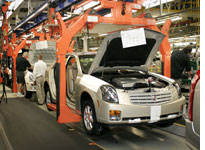The press is buzzing with President-elect Barack Obama’s proposed stimulus package to create 2.5 million jobs over two years. Among the jobs most often mentioned is the insulation installer, who’ll help make homes and other buildings more energy efficient. At the same time, we're inundated with stories of the potential bankruptcy of one or more of the Big 3 automakers that could results in tens of thousands of assembly workers losing their jobs.
How much pay would the average autoworker lose if he or she became an insulation installer? A lot. The insulation installer earns about 75% of what an autoworker makes.
According to the Bureau of Labor Statistics, based on May 2007 figures, the mean salary of an
assembler at a motor-vehicle manufacturer was $20.28 an hour or $42,190 a year. For an
insulation installer: $15.04 an hour or $31,280 annually. But the gap between the two occupations is likely greater, considering that the autoworkers whose jobs are threatened work in unionized shops, where the salaries are about $28 an hour, according to an analysis conducted by Jonathan Cohn,
published on
The New Republic's website.
Of course, most of these new installers won’t be former autoworkers. Still, what these numbers show is that some green occupations will not offer salaries anywhere near as high of those paid by old-line manufacturers. But that’s not news, is it? And, the government projects growth in insulation installation jobs by 2016 but not those on America's assembly lines.
Here's what the BLS said about employment growth for insulation workers in the 2008-2009 edition of its
Occupation Outlook Handbook, published before the need for a new stimulus package was imagined:
Employment of insulation workers is expected to increase 8 percent during the 2006-16 decade, about as fast as the average for all occupations. Demand for insulation workers will be spurred by the continuing need for energy efficient buildings and power plant construction, both of which will generate work in existing structures and new construction.
BLS wasn't optimistic about assembly line workers (it didn't provide specific numbers on autoworkers):
Employment of assemblers and fabricators is expected to decline slowly by 4% between 2006 and 2016. Within the manufacturing sector, employment of assemblers and fabricators will be determined largely by the growth or decline in the production of certain manufactured goods.
 a letter to The Wall Street Journal, Accenture U.K. and Ireland managing director David Thomlinson writes: There is plenty of competition for clean technologies, but no country has yet established a leadership position in the evolution of smart grids.
a letter to The Wall Street Journal, Accenture U.K. and Ireland managing director David Thomlinson writes: There is plenty of competition for clean technologies, but no country has yet established a leadership position in the evolution of smart grids.






